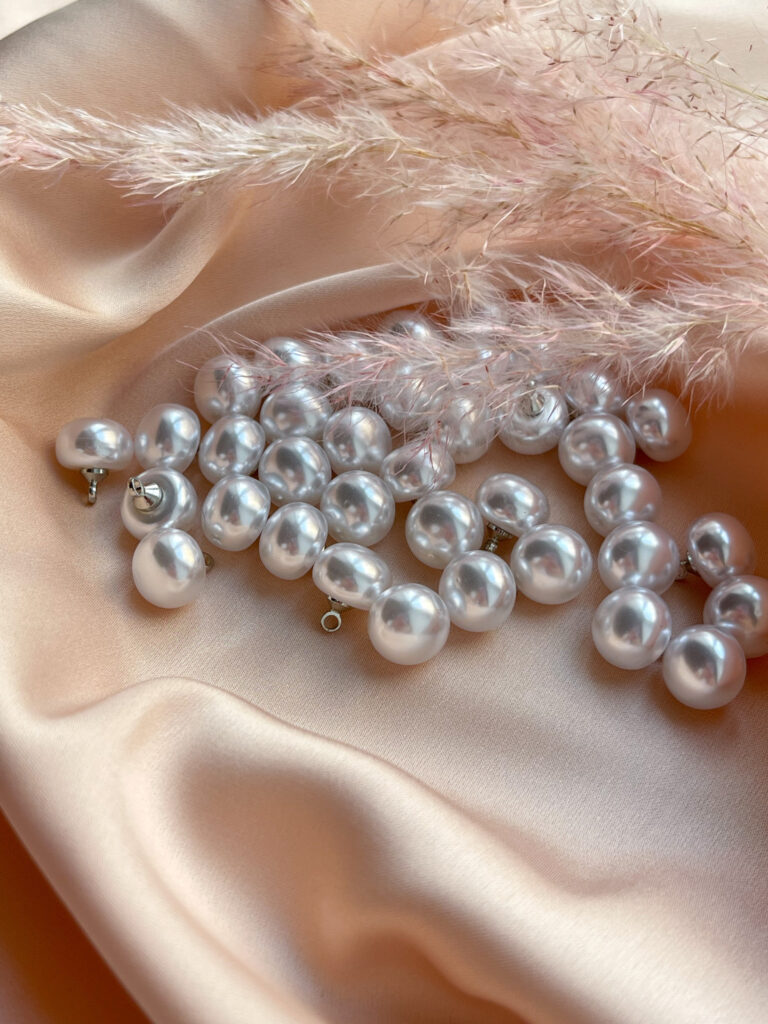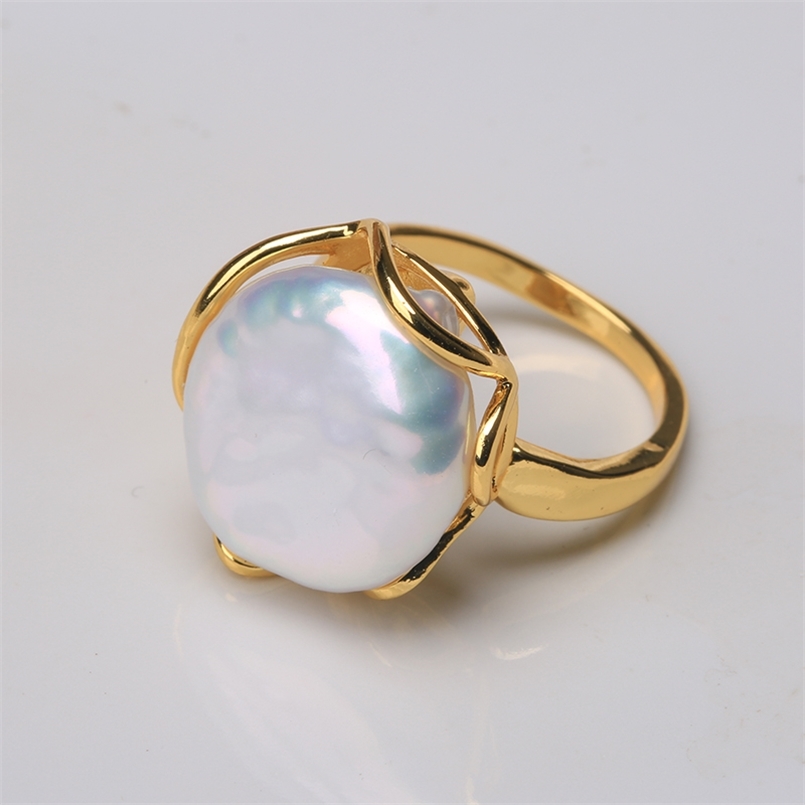Vintage Faux Pearl ring
Artificial Pearls origin
Artificial pearls, also known as “imitation pearls,” are man-made pearls that are created using various techniques to mimic the appearance of natural pearls.
The earliest artificial pearls were created in ancient China, using materials such as fish scales, paper, and wax. Later, in the 17th century, Venetian glassmakers began to produce artificial pearls using glass beads coated with a solution made from fish scales.
In the early 20th century, Japanese inventor Kokichi Mikimoto developed a technique for culturing pearls by inserting a bead into an oyster, which led to the mass production of cultured pearls. Today, most artificial pearls are made using plastic beads coated with a substance that gives them the luster and appearance of real pearls.

What is the difference between artificial and natural pearls
The main difference between artificial and natural pearls is their origin.
Natural pearls are created when a foreign object, such as a grain of sand, enters an oyster or mollusk and irritates the soft tissue inside. The mollusk then secretes a substance called nacre, which coats the irritant in layer after layer until a pearl is formed. Natural pearls are rare and valuable because they occur spontaneously in nature and are difficult to find.
Artificial pearls, on the other hand, are man-made and created by coating a bead or other material with a substance that imitates the appearance of nacre. These can be mass-produced, and their quality and luster can be controlled, making them less expensive and more accessible than natural pearls.
In terms of appearance, natural pearls have a unique beauty and luster that cannot be fully replicated in artificial pearls. They may also have slight irregularities in shape, size, and color due to their natural formation, which adds to their charm and value. Artificial pearls, however, can be made in uniform shapes, sizes, and colors, which can make them more suitable for certain jewelry designs.
Overall, while natural pearls are considered more valuable and unique, artificial pearls provide a more affordable option for those who want the look of pearls without the high cost associated with natural ones.
Artificial pearls what is it
Artificial pearls, also known as “imitation pearls,” are man-made pearls that are created using various techniques to mimic the appearance of natural pearls. They are not formed by a living organism like natural pearls, but instead are created by humans using different materials such as glass, plastic, or ceramic.
The process of creating artificial pearls typically involves coating a small bead or nucleus with a substance that imitates the appearance of nacre, the iridescent substance that coats the inside of a mollusk shell and forms the lustrous surface of natural pearls. This coating may consist of several layers of a pearlescent material, such as a mixture of fish scales and varnish or a synthetic substance, that can create a similar appearance to natural pearls.
Artificial pearls are generally less expensive than natural pearls, and they can be made in a wider range of colors and shapes, making them a popular choice for costume jewelry and fashion accessories. However, they do not have the same rarity, beauty, and value as natural pearls, which are highly prized for their unique character and the labor-intensive process of their formation.
Features of manufacturing of different types
Artificial pearls can be made using a variety of methods and materials. Here are some common types of artificial pearls and their features:
- Glass pearls: These are made by coating a glass bead with a layer of pearlized coating. They are usually lightweight and have a consistent shape and color. They can be made in a wide range of sizes and colors.
- Plastic pearls: These are made from various types of plastics, such as acrylic or polystyrene. They are typically lightweight and have a smooth surface. They are available in a variety of shapes and sizes, and can be produced in a wide range of colors.
- Shell-based pearls: These are made from ground-up shells, which are then mixed with a binding material and shaped into pearls. They often have a more natural look and feel than glass or plastic pearls. They can be made in a range of sizes and colors.
- Freshwater pearls: These are produced by inserting a small piece of tissue or bead into the mantle tissue of a freshwater mussel. The mussel then forms a pearl around the foreign object. Freshwater pearls can vary in size and shape, and can have a variety of colors and surface textures.
- Cultured pearls: These are similar to freshwater pearls, but they are produced using saltwater mollusks. They can be round or irregular in shape and are available in a range of colors. Cultured pearls are often more expensive than freshwater pearls.
Overall, the choice of material and method used to make artificial pearls will affect their appearance, weight, and cost.
Pros and cons of imitation
Imitation or artificial pearls offer a range of advantages and disadvantages compared to genuine pearls. Here are some of the main pros and cons:
Pros:
- Affordability: Imitation pearls are often much more affordable than genuine pearls, making them accessible to a wider range of people.
- Durability: Artificial pearls are often more durable than genuine pearls because they are less likely to chip, scratch, or discolor.
- Consistency: Imitation pearls are produced in a controlled environment, so they can be made in consistent shapes, sizes, and colors.
- Availability: Because they are mass-produced, artificial pearls are often widely available in a range of styles and colors.
Cons:
- Value: Artificial pearls have less value than genuine pearls because they are not made from natural materials.
- Quality: The quality of imitation pearls can vary widely depending on the material and method used to produce them.
- Appearance: While imitation pearls can be made to look similar to genuine pearls, they may not have the same luster, surface texture, or depth of color.
- Environmental impact: Some artificial pearls are made from plastic materials, which can have a negative impact on the environment if not properly buydo.eu disposed of or recycled.
Overall, imitation pearls can be a more affordable and durable alternative to genuine pearls, but they may not have the same value, quality, or appearance.
Vintage Faux Pearl ring
A Vintage Faux Pearl ring is a piece of jewelry that features an imitation or artificial pearl that was created in the past, typically at least 20 years ago. The ring may be made from a variety of materials, such as metal, plastic, or glass, and the pearl may be a variety of shapes and sizes.
Vintage faux pearl rings can be an affordable and stylish alternative to genuine pearl rings. They often have a unique character and charm that can be difficult to find in modern jewelry. Additionally, vintage pieces may have historical or sentimental value, as they may have been passed down through generations or purchased as a special gift.
When purchasing a vintage faux pearl ring, it’s important to inspect the piece carefully to ensure it’s in good condition. Look for signs of wear or damage, such as scratches or missing pearls. Consider the size and shape of the ring to ensure it will fit comfortably and suit your personal style.
Overall, a vintage faux pearl ring can be a beautiful and meaningful addition to any jewelry collection.

Care for vintage jewelry made of artificial pearls
Vintage jewelry made of artificial pearls can be delicate and require special care to maintain their beauty and prolong their lifespan. Here are some tips to help you care for your vintage pearl jewelry:
- Store your pearls separately: To prevent your vintage pearl jewelry from scratching or damaging other jewelry, store it separately in a soft pouch or jewelry box lined with soft fabric.
- Keep them dry: Avoid getting your vintage pearl jewelry wet as moisture can damage the pearls. Also, avoid storing them in damp places like the bathroom.
- Avoid direct sunlight: Prolonged exposure to sunlight can cause the pearls to fade or change color. It’s best to store your vintage pearl jewelry in a cool and dark place.
- Handle with care: When wearing your vintage pearl jewelry, handle it with care. Avoid pulling or tugging on the pearls, and avoid spraying perfume or hairspray directly on them.
- Clean gently: To clean your vintage pearl jewelry, use a soft cloth dampened with water and mild soap. Avoid using harsh chemicals or abrasive cleaners.
- Have them restrung: If you notice that the thread or wire holding the pearls together is fraying or showing signs of wear, it’s best to have them restrung by a professional jeweler. This will help prevent the pearls from falling off or getting lost.
By following these tips, you can help preserve your vintage pearl jewelry and enjoy it for many years to come.





0 Comments for “Vintage Faux Pearl ring”